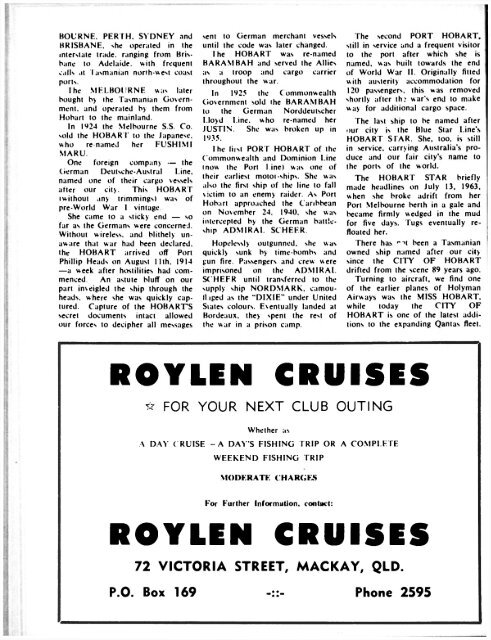Feb-Mar-Apr 1968 - Navy League of Australia
Feb-Mar-Apr 1968 - Navy League of Australia
Feb-Mar-Apr 1968 - Navy League of Australia
Create successful ePaper yourself
Turn your PDF publications into a flip-book with our unique Google optimized e-Paper software.
BOURNE. PERTH. SYDNEY and<br />
BRISBANE, she operated in the<br />
interstate trade, ranging from Brisbane<br />
to Adelaide, with frequent<br />
calls at Tasmanian north-west coast<br />
ports.<br />
Ihe MELBOURNE was later<br />
bought by ihe Tasmanian Government.<br />
and operated b> them from<br />
Hobart to the mainland.<br />
In IV24 the Melbourne S.S. Co.<br />
sold the HOBART to the Japanese,<br />
who renamed her FUSHIMI<br />
MARU.<br />
One foreign company — the<br />
German Deutsche-Austral Line,<br />
named one <strong>of</strong> their cargo vessels<br />
after our cit>. This HOBART<br />
iwithout any trimmings) was <strong>of</strong><br />
pre-World War I vintage<br />
She came to a sticky end — so<br />
far as the Germans were concerned.<br />
Without wireless, and blithely unaware<br />
that war had been declared,<br />
the HOBART arrived <strong>of</strong>f Port<br />
Phillip Heads on August 11th. 1914<br />
—a week after hostilities had commenced.<br />
An astute bluff on our<br />
part inveigled the ship through the<br />
heads, where she was quickly captured.<br />
Capture <strong>of</strong> the HOBARTS<br />
secret documents intact allowed<br />
our forces to decipher all messages<br />
sent to German merchant vessels<br />
until the code was later changed.<br />
Ihe HOBART was re-named<br />
BARAMBAH and served the Allies<br />
as a troop and cargo carrier<br />
throughout the war.<br />
In 1925 the Commonwealth<br />
Government sold the BARAMBAH<br />
to the German Norddeutscher<br />
Lloyd Line, who re-named her<br />
JUSTIN. She was broken up in<br />
1935.<br />
Ihe liist PORT HOBART <strong>of</strong> the<br />
Commonwealth and Dominion Line<br />
(now the Port line) was one <strong>of</strong><br />
their earliest motoi-ships. She was<br />
also the first ship <strong>of</strong> the line to fall<br />
victim to an enemy raider. As Port<br />
Hobart approached the Caribbean<br />
on November 24. 1940. she was<br />
intercepted by the German battleship<br />
ADMIRAL SCHEER.<br />
Hopelessly outgunned, she was<br />
quickly sunk by time-bombs and<br />
gun fire. Passengers and crew were<br />
imprisoned on the ADMIRAL<br />
SCHEFR until transferred to the<br />
supply ship NORDMARk. camou-<br />
11 iged as the "DIXIE" under United<br />
Slates colours. Eventually landed at<br />
Bordeaux, they spent the rest <strong>of</strong><br />
the war in a prison camp.<br />
The second PORT HOBART,<br />
still in service and a frequent visitor<br />
to the port after which she is<br />
named, was built towards the end<br />
<strong>of</strong> World War II. Originally fitted<br />
with austerity accommodation for<br />
120 passengers, this was removed<br />
shortly after th: war's end to make<br />
way for additional cargo space.<br />
The last ship to be named after<br />
our city is the Blue Star Line's<br />
HOBART STAR. She, too. is still<br />
in service, carrying <strong>Australia</strong>'s produce<br />
and our fair city's name to<br />
the ports <strong>of</strong> the world.<br />
The HOBART STAR briefly<br />
made headlines on July 13. 1963.<br />
when she broke adrift from her<br />
Port Melbourne berth in a gale and<br />
became firmly wedged in the mud<br />
for five days. Tugs eventually refloated<br />
her.<br />
There has '•-

















